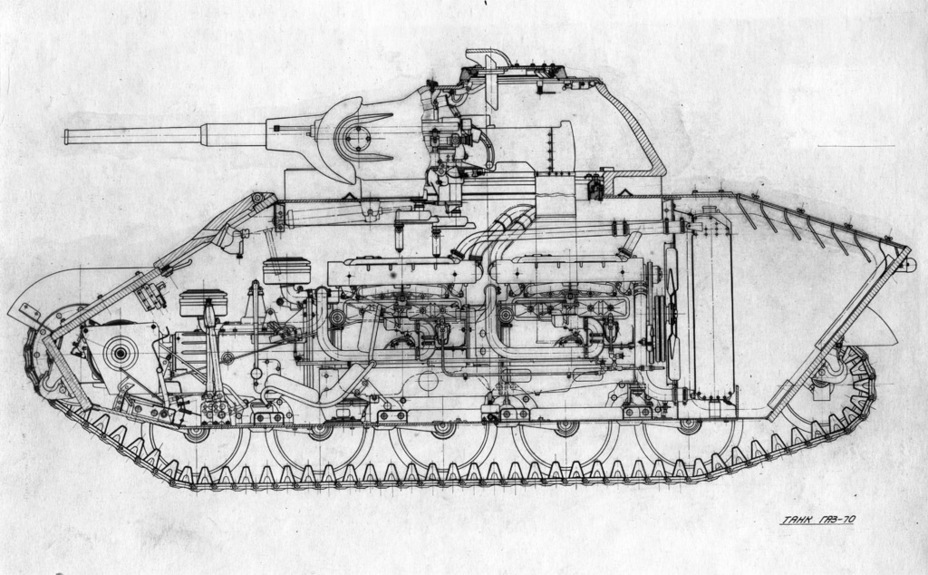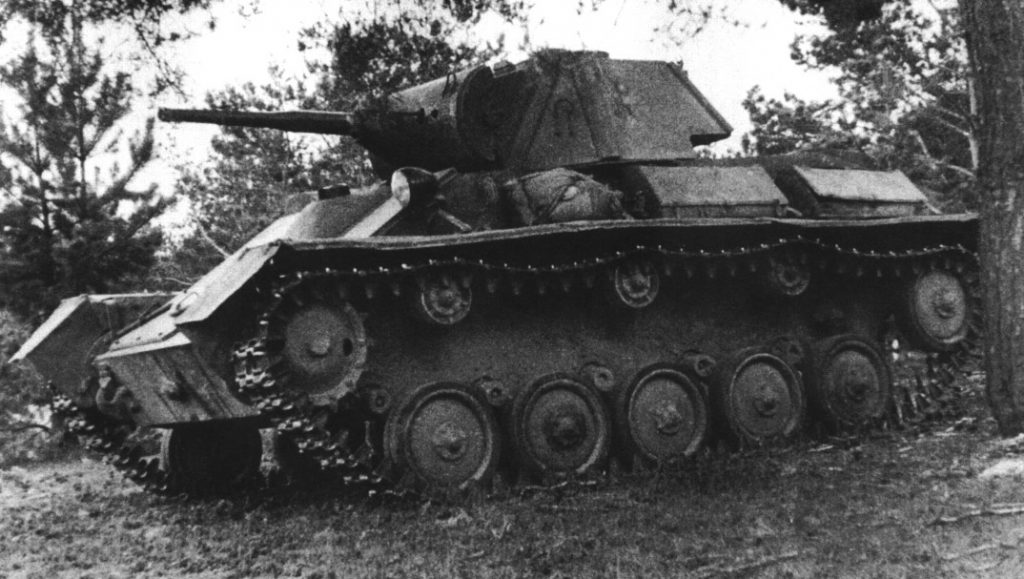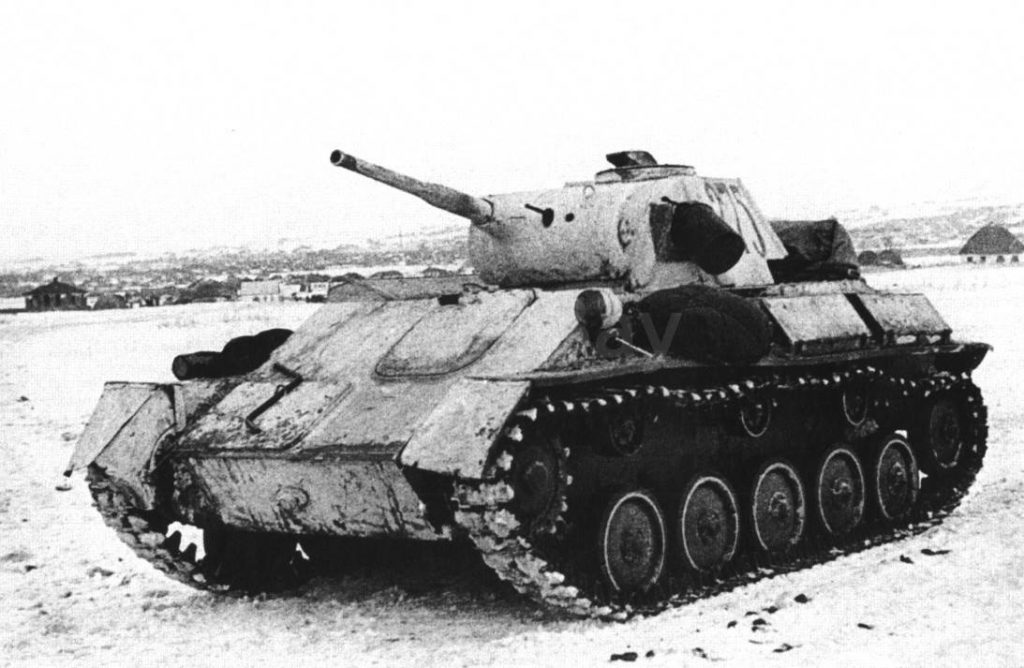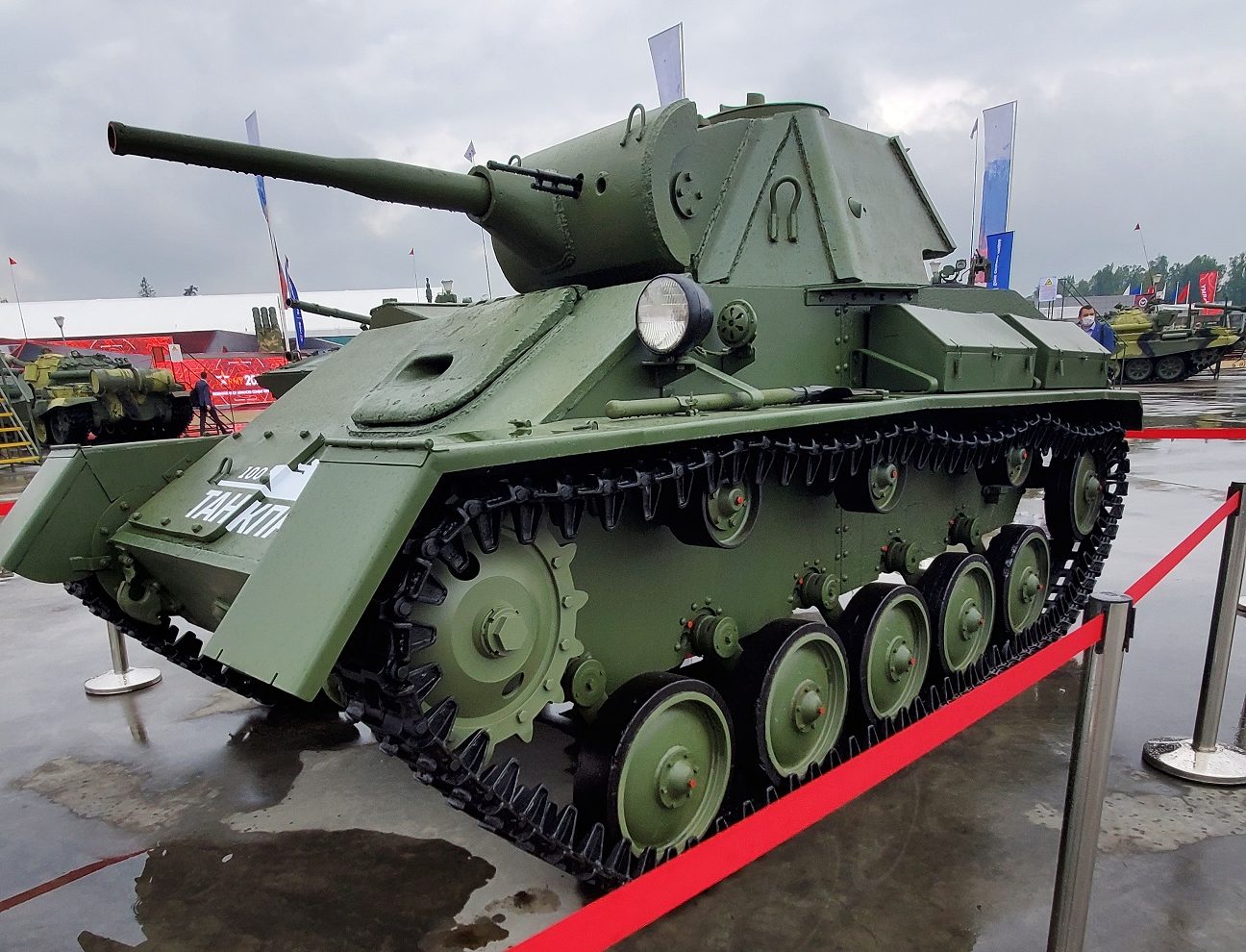T-70 – Soviet light tank of the Second World War.
 Developed in October – November 1941 at the Gorky Automobile Plant (GAZ) under the leadership of Nikolai Alexandrovich Astrov, the leading developer of the entire domestic line of light tanks of that period. In January 1942, the T-70 was adopted by the Workers ‘and Peasants’ Red Army and was mass-produced at several machine-building plants. Production of the T-70 continued until October 1943, when, according to the results of the hostilities of this summer and the great need of the Red Army for the SU-76 self-propelled artillery mounts on its basis, it was decided to terminate its serial production. A total of 8231 tanks of this type were produced.
Developed in October – November 1941 at the Gorky Automobile Plant (GAZ) under the leadership of Nikolai Alexandrovich Astrov, the leading developer of the entire domestic line of light tanks of that period. In January 1942, the T-70 was adopted by the Workers ‘and Peasants’ Red Army and was mass-produced at several machine-building plants. Production of the T-70 continued until October 1943, when, according to the results of the hostilities of this summer and the great need of the Red Army for the SU-76 self-propelled artillery mounts on its basis, it was decided to terminate its serial production. A total of 8231 tanks of this type were produced.
Since the summer of 1942, light tanks T-70 took an active part in the battles of the Great Patriotic War. The apogee of their military service was the Battle of Kursk, after which they began to disappear from the units of the Red Army, although individual copies were used until the end of the war. In terms of the number of vehicles produced, the T-70 became the second largest type of tank in the Red Army in 1941-1945. At the end of 1942, a light self-propelled artillery unit for direct support of infantry SU-76, a number of prototypes of light tanks with improved armament or ergonomics, and prototypes of anti-aircraft tanks were built on the basis of the T-70 at the end of 1942. Soon after the end of the war, the T-70 was withdrawn from service by the Soviet army…. A fairly large number of such tanks have survived to our time in military museums and memorials in Russia, the CIS countries and non-CIS countries.
For the first time, the T-70 went into battle in the summer of 1942, in the Southwest direction. The 4th Panzer Corps of the 21st Army of the Southwestern Front, as of June 26, had 30 T-70s out of 145 tanks in its composition, but after the start of the German offensive on June 28, they were all quickly lost – by July 7 they were gone… Immediately, the tankers of the Red Army had to make sure of the low combat effectiveness of the vehicle both against enemy armored vehicles and with the support of their infantry. “Seventies” could not fight the most common German tanks PzKpfw III and PzKpfw IV, as well as the StuG III self-propelled guns. In battle, and as a tank for direct support of the infantry, it had insufficient armor protection. On the battlefield, the 75 mm Pak 40 anti-tank guns were increasingly encountered, which could successfully hit the T-70 with the first projectile from any distance and battle angle. Only the small size and good mobility of the T-70 served as some protection. For this reason, the T-70, as a rule, was used in reconnaissance companies of tank brigades.

Nevertheless, he was not an unanswered target; Soviet wartime documents contain many examples of the successful actions of the Seventies. Excerpt from the Journal of hostilities 150 the Tank Brigade (Voronezh Front, 40th Army) for 3 – 24 January 1943 the year in the area of snatching evidence:
Senior Lieutenant Zakharchenko and driver-mechanic Senior Sergeant Krivko, repelling the counterattacks of tanks and using up the shells, went to ram German tanks with their entire T-70 company. Zakharchenko himself personally rammed 2 tanks and captured the commander and chief of staff of the 100th Special Purpose Tank Battalion.
The same brigade during the Lgov operation again distinguished itself in January 1943 near the village of Semyonovsky:
Captain Dyachenko with two T-70s captured 4 guns and 32 prisoners, and destroyed 8 gun servants. For his part, he had no losses.
All T-70 tanks of the 28th Guards Tank Brigade of the 39th Army were named.. Among their titles were “Varyag”, “Typhoon”, “Pomegranate”, “Rakhmatullin,” etc. The brigade took part in the fighting 13 – on August 15 of 1943, at the village Ponizova and destroyed up to 300 people, 6 antitank guns, 4 bunkers, 3 machine gun, 1 self-propelled gun and 2 cars. Losses of the brigade were also heavy – 25 T-34s and 8 T-70s. The authors of the article in “Front illustration” M. Kolomiets and M. Svirin separately note that, thanks to the use of the T-70 in wooded and swampy terrain and the smaller size in comparison with the T-34, the former suffered significantly less losses with an equal combat intensity with the latter application. T-70 tanks proved to be quite successful during the 24th Panzer Corps raid on the village of Tatsinskaya.
The climax of the combat use of the “seventy” was the Battle of Kursk. T-70s made up a significant part of the Soviet tank fleet – of 1487 (the evening of July 4, 1943), 369 tanks (about 22%) of the Central Front were exactly “seventy”. During the battle that began early in the morning on July 5, 1943, the T-70, like all other types of Soviet and Lend-Lease tanks, suffered heavy losses. In the oncoming tank battle, the T-70 was hit without problems, but it is interesting that the percentage of irrecoverable losses in the gasoline “seventy” was lower than that of the diesel and better armored “thirty-four”. In particular, in the famous battle at Prokhorovka on July 12, among other units, 212 tanks and self-propelled guns of the 29th Tank Corps of the 5th Guards Tank Army participated. Of these, 122 were T-34s, 70 were T-70s and 20 were self-propelled guns. Calculation of losses after the battle showed that the enemy disabled 95 T-34, 35 T-70 and 19 self-propelled guns. Irrecoverable losses amounted to 75 T-34 (60% of the total number of disabled vehicles of this type), 28 (40%) T-70 and 14 (74%) ACS. The number of survivors and fit for repair (42 units out of 70, 60%) of the T-70 was significantly higher than that of the T-34 (47 out of 122, 39%).
After production was discontinued in October 1943, T-70s began to rapidly disappear from Soviet units, and already in 1944 there were very few of them. Most often they were used as training or command vehicles in self-propelled artillery units armed with SU-76M. For example, as of May 10, 1945, the tank units of the 2nd Ukrainian Front had nine T-70s out of a total of 381 tanks and self-propelled guns. An interesting fact already “after the life” of the T-70 was the statement by the OGK NKTP RKKA of their effectiveness in fighting in cities. When working out the terms of reference for a light tank that met the requirements of 1944, it was noted that the experience of military operations in cities showed a good survival rate of the “seventy”. Good manoeuvrability and small size made it difficult to fire from faust cartridges and throw grenades at them by the enemy, a light tank looked better when penetrating into narrow places, it was easier to evacuate if damaged. Despite the withdrawal of light tanks from combat units, as of January 1, 1946, 1502 T-70 tanks were still in service with the Red Army. However, the operation of the T-70 ended already in the early post-war years, when in mid-1946 it was decided to send the tanks to be overhauled to be scrapped, with the removal of serviceable engines and other units from them and using them to maintain the fleet of the SU-76M ACS.
Other countries
A number of T-70s were part of the Polish Army (53 tanks) and the Czechoslovak army (10 tanks), formed in the USSR. As of May 1945, 12 T-70Ms were in service with the 1st Warsaw separate reconnaissance motorized rifle battalion, and a certain number of vehicles of this type were at the disposal of the 3rd training tank regiment. In total, 41 T-70M tanks were in service with the Polish Army on July 16, 1945. Another 11 T-70s were transferred by the USSR to the Polish Army and the Polish Ministry of Public Security in 1946-1947 at their request… Nevertheless, in the course of the post-war reorganization of the Polish army in 1945-1948, the T-70s were considered unsuitable for use even as training and were completely withdrawn from service no later than 1949; As in the USSR, the units removed from them were used to maintain the SU-76M fleet.
The seventies captured by the Wehrmacht were adopted as the Panzerkampfwagen T70 (r). According to M. Svirin and M. Kolomiets, there were no more than 50 vehicles, most often they were used in infantry divisions and the police (Ordnungspolizei). In the 5th and 12th police tank companies (Polizeipanzerkompanie), captured T-70s served until the end of 1944. A significant number of “seventy” with the towers removed were used as armored tractors of the Pak 38 and Pak 40 anti-tank guns.
Combat Use and Evaluation

The main idea of the “seventy”, created in the extreme conditions of wartime, was to obtain the maximum manufacturability and reliability of the structure, created on the basis of aggregates of mass army vehicles, with the enhancement of weapons and armor to a level adequate to the enemy’s anti-tank artillery and the protection of his tanks. As a result of this approach, the production volumes of the T-70 at non-specialized enterprises turned out to be very high, the tank itself is the best in terms of reliability in comparison with the T-34 or KV-1.release in 1942, but the price for these advantages was the small potential for further development of the design and the functional overload of the vehicle commander. An attempt to overcome the second most serious drawback ran into the “pitfalls” of the first. Although a three-seater improved version of the T-70 was built, it was adopted by the Red Army under the T-80 brand.and even launched into series, the insufficient power of the GAZ-203 power plant forced the designers to force it with a significant decrease in reliability, which almost immediately led to complaints from the troops. In the person of its “heir” T-80 “seventy” actually had the last reserves of its design involved. The main advantage of the above approach to the creation of light tanks has disappeared as a result of the inevitable increase in requirements for the combat properties of the tank. At the same time, by 1943, the production of the T-34 was optimized in order to reduce costs, and their quality was already considered satisfactory.
The second factor that had a negative impact on the assessment of the T-70 was the rapid development of German tank and anti-tank artillery. The appearance on the battlefield in large numbers of T-34s required the Germans to qualitatively reinforce their guns. During 1942, the Wehrmacht received a large number of 50-mm and 75-mm anti-tank guns, tanks and self-propelled guns, armed with long-barreled 75-mm cannons. 75-mm long-barreled cannons had no problems in the defeat of the T-70 at any angle and distance of the battle; the sides of the latter were also vulnerable to artillery of smaller calibers, up to the obsolete 37-mm Pak 35/36 cannon. As a result, in an open tank battle, the “seventy” no longer had a chance, and even when breaking through the anti-tank defense, the T-70 units were doomed to high losses.
For these reasons, the T-70 has earned itself an unflattering reputation. However, even when the enemy had anti-tank weapons capable of successfully hitting the T-70, he was fully combat-ready with the correct use of units of such tanks. This application included: pursuit of retreating enemy forces, infiltration and daring raids on the rear of the enemy, reconnaissance. In all the listed types of actions of the T-70 units, the attack of the enemy’s armored forces was to be carried out mainly from ambushes. This was only facilitated by the small size and low noise of the “seventy”. It is known that two Panther tanks were defeated by one T-70 (commander G. I. Pegov, 3rd Guards Tank Army) from an ambush, which only confirms the combat effectiveness of the tank even in the conditions of 1944-1945.
Using these advantages, one T-70 of the 55th brigade under the command of M. Solomin was able to complete the task of attacking the enemy stronghold, while in the previous attack 6 T-34s and 2 M3 Grant were lost.
However, only experienced and tactically competent commanders of armored units could reveal the capabilities of the T-70 in this way. In addition, regardless of the intentions and plans of the command, the tactical “offensive one-sidedness” of light tank subunits was potentially dangerous with high losses and destruction with rapid changes in the situation as a result of adequate measures on the part of the enemy. In general, the experience of World War II finally showed that in the conditions of a sharp increase in the power of anti-tank defense, a light tank is fundamentally unsuitable as the basis of the material part of tank formations, and its tactical role is very narrow. To date, this situation has not changed. The percentage of irrecoverable losses of “seventy” among the Soviet tanks disabled by the enemy was lower compared to the T-34 – according to frontline reports,detonation of the T-70’s ammunition was a rare occurrence. The damaged T-70s were easier to evacuate to the rear, and many of them were amenable to field repair.






